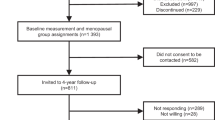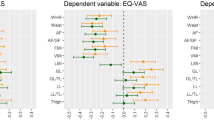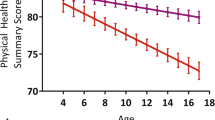Abstract
OBJECTIVE: To explore relationships between body mass index (BMI, kg/m2) and indicators of health and well-being in young Australian women.
DESIGN: Population based cohort study—baseline cross sectional data.
SUBJECTS: 14,779 women aged 18–23 who participated in the baseline survey of the Australian Longitudinal Study on Women's Health in 1996.
MEASUREMENTS: Self-reported height, weight, medical conditions, symptoms and SF-36.
RESULTS: The majority of women (68%) had a BMI in the range 18.5–<25; 12% had a BMI <18.5; 14% had a BMI in the range 25–<30 and 6% had a BMI ≥30. After adjustment for area of residence, age, education, smoking and exercise, women in the highest BMI category (≥30) were more likely to report hypertension, asthma, headaches, back pain, sleeping difficulties, irregular periods, and more visits to their medical practitioner. They were also more likely to have given birth at least once, and less likely to report ‘low iron’. Women with low BMI (<18.5) were more likely to report irregular periods and ‘low iron’. Mean scores on the SF-36 sub-scales for physical functioning, general health and vitality were highest for women with BMI in the range 18.5–25.
CONCLUSION: Acknowledging the limits of the cross-sectional nature of the data, the results show that the deleterious effects of overweight can be seen at a comparatively young age, and that BMI <25 is associated with fewer indicators of morbidity in young women. However, as BMI lt;18.5 is associated with low iron and irregular periods, care should be taken when developing strategies to prevent overweight in young women, not to encourage women with healthy weight to strive for a lower BMI.
This is a preview of subscription content, access via your institution
Access options
Subscribe to this journal
Receive 12 print issues and online access
$259.00 per year
only $21.58 per issue
Buy this article
- Purchase on Springer Link
- Instant access to full article PDF
Prices may be subject to local taxes which are calculated during checkout


Similar content being viewed by others
References
Dwyer J . Policy and healthy weight Am J Clin Nutr 1996 63: 415S–418S.
Metropolitan Life Insurance Company . 1983 height and weight tables Stat Bull Metrop Insur Co 1984 64: 2–9.
Brown WJ, Dobson AJ, Mishra G . What is healthy weight for middle aged women? Int J Obes Relat Metab Disord 1998 22: 520–528.
Ware JE, Kosinski M, Keller SD . SF 36 Physical and mental health summary scales: a user's manual The Health Institute, New England Medical Center; Boston MA, 1994.
US Department of Agriculture and US Department of Health and Human Services . Nutrition and your health: dietary guidelines for Americans, 3rd ed (Home and garden bulletin no. 232) US Department of Agriculture: Washington DC 1990.
National Health and Medical Research Council . Report of the one hundredth session Australián Government Publishing Service: Canberra 1985.
World Health Organization Expert Committee on Physical Status . Physical status: the use and interpretation of anthropometry World Health Organization: Geneva 1995.
Meisler JG, St Jeor S . Summary and recommendations from the American Health Foundation's expert panel on healthy weight Am J Clin Nutr 1996 63: 474S–477S.
French SA, Jeffery RW . Consequences of dieting to lose weight: effects on physical and mental health Health Psychol 1994 13: 195–212.
Kenardy J, Brown WJ, Vogt E . Dieting and health in young Australian women Europ Eating Disorders Review (in press).
Green BB, Weiss NS, Daling JR . Risk of ovulatory infertility in relation to body weight Fertil Steril 1988 50: 721–726.
Grodstein F, Goldman MB, Cramer DW . Body mass index and ovulatory infertility Epidemiology 1994 5: 247–250.
Ward A, Brown N, Treasure J . Persistent osteopenia after recovery from anorexia nervosa Int J Eat Disord 1997 22: 71–75.
Frisch RE . Body fat, menarche, fitness and fertility Hum Reprod 1987 2: 521–533.
Villena-Heinsen C, Luxner K, Friedrich M, Quijano F, Schmidt W . Schwangerschafts- und Geburtsverlauf bei untergewichtigen Schwangeren Z Geburtshilfe Neonato 1998 202: 115–120.
Robinovich JT, Rubio EL, Saez JC, Ramirez MI . Influencia del peso corporal en el embarazo y resultado perinatal Rev Chile Obstet Ginecol 1995 6: 151–167.
Maugars Y, Berthelot JM, Lalande S, Charlier C, Prost A . Osteoporotic fractures revealing anorexia nervosa in five females Rev Rhumatisme 1996 63: 201–206.
Brown WJ, Bryson L, Byles JE, Dobson AJ, Lee C, Mishra G, Schofield M . Women's Health Australia: recruitment for a national longitudinal cohort study Women Health 1998 28: 23–40.
Ware JE, Snow KK, Kosinski M, Gandek B . SF-36 health survey manual and interpretation guide The Health Institute, New England Medical Center: Boston, MA, 1993.
Cleveland WS . Robust locally weighted regression and smoothing scatterplots JASA 1979 74: 829–836.
Mathsoft . S-PLUS reference manual, Vol 1. Mathsoft: Seattle, WA, 1995.
Department of Primary Industries and Energy and Department of Human Services and Health . Rural, remote and metropolitan areas classification: 1991 Census edition Australian Government Publishing Service: Canberra 1994.
SAS Institute Inc . SAS/STAT Users guide, version 6, 4th edn, Vol 2. SAS Institute Inc., Cary, NC 1989.
Australian Bureau of Statistics . 1996 Census customised matrices Australian Government Publishing Service: Canberra 1996.
Goroll AH, May LA, Mulley AG . Hematology. In Winters R (ed). Primary Care Medicine, 3rd edn. JB Lippincott: Philadelphia, AA 1995, pp 444–445.
Patterson AJ . Iron deficiency in Australian women: development, implications and treatment. PhD thesis University of Newcastle, NSW, Australia 1999.
Lake JK, Power C, Cole TJ . Women's reproductive health: the role of body mass index in early and adult life Int J Obes Relat Metab Disord 1997 21: 432–438.
Australian Institute of Health and Welfare, University of New South Wales . Australian mothers and babies 1996. Perinatal Statistics Series no. 7. Australian Institute of Health and Welfare: Canberra 1999.
Gortmaker SL, Must A, Perrin JM, Sobol AM, Dietz WH . Social and economic consequences of overweight in adolescence and young adulthood New Engl J Med 1993 329: 1008–1012.
Stunkard AJ, Sorensen TIA . Obesity and socioeconomic status—a complex relation New Engl J Med 1993 329: 1036–1037.
Carpenter L, Bartley M . Fat, female and poor Lancet 1994 344: 1715–1716.
Young AF . General practitioner utilisation among women in Australia. PhD thesis, 1999 University of Newcastle, NSW, Australia.
Australian Institute of Health and Welfare (AIHW) . Australia's health 1998 AIHW: Canberra 1998.
Acknowledgements
The Women's Health Australia project, which was conceived and developed by groups of inter-disciplinary researchers at the Universities of Newcastle and Queensland, is funded by the Commonwealth Department of Health and Aged Care. The assistance of Joy Goldsworthy with the preparation of this paper is also gratefully acknowledged. Finally, we would like to thank all the participants for their valuable contribution to this project.
Author information
Authors and Affiliations
Corresponding author
Rights and permissions
About this article
Cite this article
Brown, W., Mishra, G., Kenardy, J. et al. Relationships between body mass index and well-being in young Australian women. Int J Obes 24, 1360–1368 (2000). https://doi.org/10.1038/sj.ijo.0801384
Received:
Revised:
Accepted:
Published:
Issue Date:
DOI: https://doi.org/10.1038/sj.ijo.0801384
Keywords
This article is cited by
-
Familiarity with Own Population’s Appearance Influences Facial Preferences
Human Nature (2017)
-
Association Between Obesity and Migraine in Women
Current Pain and Headache Reports (2017)
-
O032. Associations between any headache and obesity: results from a systematic review and meta-analysis of observational studies
The Journal of Headache and Pain (2015)
-
Migraine and body mass index categories: a systematic review and meta-analysis of observational studies
The Journal of Headache and Pain (2015)
-
The impact of a weight reduction program with and without meal-replacement on health related quality of life in middle-aged obese females
BMC Women's Health (2014)



